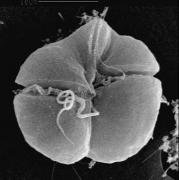Long wavelengths of light such as red and yellow and very short wavelengths such as ultraviolet light (UV) get absorbed very quickly in water. As a result, the only light remaining in the deep ocean is blue.
Organisms are therefore adapted to see only this dim blue light, and most are colored red because the lack of red light makes them virtually invisible.




